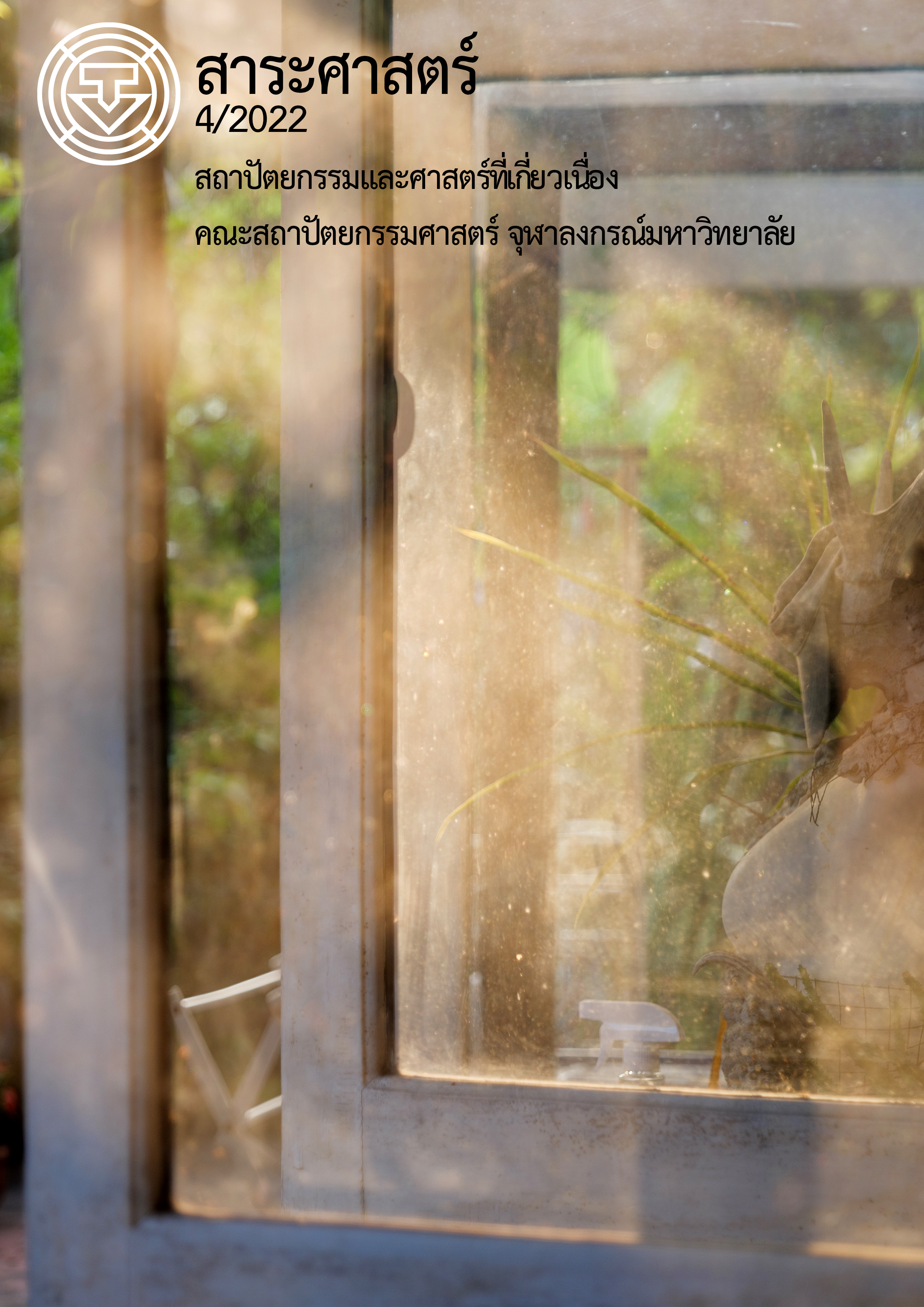Community Participatory Process in the Development of Abandoned Area Beneath an Expressway: A Case Study of Lan Kila Phat 2
Main Article Content
Abstract
Bangkok metropolitan has various empty spaces under the expressways which are mostly adjacent to urban slum communities, abandoned with problems, and waiting to be improved for utilization. In order to sustainably utilize the area, the surrounding communities should participate actively in the development process. This study aimed to investigate: 1. problems of abandoned areas under the expressways and their effects on the residents living near the Lan Kila Phat 2; 2. the development process of transforming the abandoned area under the expressway to a sports ground appropriated for the urban community context; and 3. roles of relevant organizations in supporting the development of the abandoned area under the expressway to be Lan Kila Phat 2. The research operation followed the qualitative research methodology. Data were collected by means of in-depth interview with 15 key informants who were involved in the development of Lan Li. Results revealed as follows: 1. prior to the development of the area to become Lan Kila Phat 2, residents of nearby communities were affected by an unsafe and unpleasant environment resulted from the abandonment of the area; 2. the development process of Lan Kila Phat 2 focused on participation of members of nearby communities in various steps corresponding to the bottom-up development approach including the appointment of a working committee to be a supporting mechanism for the long-term participatory management of the area; and 3. the transformation of the abandoned area under the expressway to be Lan Kila Phat 2 was supported by various relevant organizations including the owner of the area, governmental and non-governmental organizations, that provided assistances to enable the utilization of the area, financial support for the construction, and enhancement of community participation in the management of the area to promote the concrete community-based development movement.
Article Details
References
กาญจนา แก้วเทพ. (2560). เครื่องมือทำงานวัฒนธรรมชุมชนและสื่อพิธีกรรมศึกษา (พิมพ์ครั้งที่ 2). กรุงเทพฯ: ศูนย์มานุษยวิทยาสิรินธร (องค์การมหาชน).
การทางพิเศษแห่งประเทศไทย. (2563). รายงานความรับผิดชอบต่อสังคม ประจำปี 2563. สืบค้นจาก https://www.exat.co.th/download/report_63/ActionPlan_2563_Q4.pdf
การทางพิเศษแห่งประเทศไทย. (2564). การพัฒนาพื้นที่ในเขตทางพิเศษ และการอนุญาตให้ใช้ประโยชน์พื้นที่ในเขตทางพิเศษ. สืบค้นจาก https://www.exat.co.th/exat_area_development/
โกวิทย์ พวงงาม. (2562). การจัดการตนเองของชุมชนและท้องถิ่น (พิมพ์ครั้งที่ 2). กรุงเทพฯ: สำนักพิมพ์ธรรมสาร.
จุฬาลงกรณ์มหาวิทยาลัย คณะสถาปัตยกรรมศาสตร์. (2553). รายงานโครงการจัดทำแผนแม่บทการพัฒนาพื้นที่ในเขตทางพิเศษ. กรุงเทพฯ: จุฬาลงกรณ์มหาวิทยาลัย.
ชมพูนุท คงพุนพิน และ ภาวิณี เอี่ยมตระกูล. (2561). การเปลี่ยนผ่านบทบาทพื้นที่สาธารณะของประเทศไทย. วารสารวิชาการคณะสถาปัตยกรรมศาสตร์ สจล., 26(1), 30-40. สืบค้นจาก https://so04.tcithaijo.org/index.php/archkmitl/article/view/132411/99425
ดวงจันทร์ อาภาวัชรุตม์ เจริญเมือง. (2551). เมืองยั่งยืน แนวคิดและประสบการณ์ของตะวันตก. เชียงใหม่: สำนักพิมพ์สถาบันวิจัยสังคม มหาวิทยาลัยเชียงใหม่.
นิรมล กุลศรีสมบัติ และ ยุวดี ศิริ. (2552). พื้นที่ทิ้งร้างกับการฟื้นฟูเมือง : กรณีพื้นที่ใต้ทางพิเศษยกระดับในกรุงเทพมหานคร.วารสารวิชาการ คณะสถาปัตยกรรมศาสตร์ จุฬาลงกรณ์มหาวิทยาลัย, (2), 77-92. สืบค้นจาก https://www.arch.chula.ac.th/journal/files/article/4MDGxPvwEYSun105252.pdf
ประยงค์ โพธิ์ศรีประเสริฐ, อิสริยา ปุณโณปถัมภ์ และ ปาสิตา อดุลทิฐิพัชร. (2558). การศึกษาเรื่องกระบวนการมีส่วนร่วมในการออกแบบสิ่งแวดล้อมที่เอื้อต่อกิจกรรมทางกาย กรณีศึกษาโครงการลานกีฬาพัฒน์ 1 ชุมชนเคหะคลองจั่น. สืบค้นจาก http://padatabase.net/uploads/files/01/doc/505_NCPA2015_p548-564.pdf
ปาจรีย์ ประเสริฐ. (2546). แนวทางการพัฒนาพื้นที่ใต้ทางด่วนในเขตกรุงเทพมหานคร. (วิทยานิพนธ์ปริญญามหาบัณฑิต, จุฬาลงกรณ์มหาวิทยาลัย).
ปาริชาติ วลัยเสถียร, พระมหาสุทิตย์ อบอุ่น, สหัสยา วิเศษ, จันทนา เบญจทรัพย์ และ ชลกาญจน์ ฮาซันนารี. (2552). กระบวนการและเทคนิคการทำงานของนักพัฒนา (พิมพ์ครั้งที่ 4). กรุงเทพฯ: สำนักงานกองทุนสนับสนุนการวิจัย.
มณฑล เยี่ยมไพศาล. (2554). การเปลี่ยนแปลงเชิงพื้นที่ของชุมชนเมือง กรณีศึกษาชุมชนใต้จุดตัดทางด่วนศรีรัชและทางด่วนเฉลิมมหานคร (วิทยานิพนธ์ปริญญามหาบัณฑิต, จุฬาลงกรณ์มหาวิทยาลัย).
ระหัตร โรจนประดิษฐ์. (2554). การออกแบบชุมชนเมืองในสหราชอาณาจักร. กรุงเทพฯ: สำนักพิมพ์แห่งจุฬาลงกรณ์มหาวิทยาลัย.
วีณา เที่ยงธรรม, สุนีย์ ละกำปั้น และ อาภาพร เผ่าวัฒนา. (2558). การพัฒนาศักยภาพชุมชน แนวคิดและการประยุกต์ใช้. กรุงเทพฯ: บริษัท แดเนกซ์อินเตอร์คอปเปอเรชั่น จำกัด.
ศุภวัลย์ พลายน้อย และ เนาวรัตน์ พลายน้อย. (2558). การประเมินภายใน : ปฎิบัติการสู่ความสำเร็จของการพัฒนาพื้นที่สุขภาวะและกิจกรรมทางกาย. กรุงเทพฯ: บริษัท พี.เอ.ลิฟวิ่ง จำกัด.
สถาบันอาศรมศิลป์. (2557). โครงการลานกีฬาพัฒน์ ใต้ทางด่วนอุรุพงษ์ ลานบ้าน ลานกีฬาพัฒน์. สืบค้นจาก http://padatabase.net/uploads/files/uploads/1507993180-2.pdf
สถาบันอาศรมศิลป์. (2561). ลานกีฬาพัฒน์ 2. สืบค้นจาก https://www.arsomsilp.ac.th/keelapatn2/
สถาบันอาศรมศิลป์. (2562). คู่มือออกแบบลานกีฬา + วัฒนธรรมชุมชน. https://dol.thaihealth.or.th/Media/Index/74e46f4d-d056-ea11-80ea-00155d09b41e
สิทธิพร ภิรมย์รื่น. (2559). การออกแบบชุมชนเมืองที่น่าอยู่ และยั่งยืน : ทฤษฎี และประสบการณ์. NAJUA: Architecture, Design and Built Environment,(22), 111-143. สืบค้นจาก https://so04.tci-thaijo.org/index.php/NAJUA-Arch/article/view/45160/37371
สนธยา พลศรี. (2553). ทฤษฎีและหลักการพัฒนาชุมชน (พิมพ์ครั้งที่ 6). กรุงเทพฯ: โอเดียนสโตร์.
สุพิชฌาย์ เกาศัลย์. (2555). การประเมินการใช้งานพื้นที่ใต้ทางด่วนเพลินจิต. (วิทยานิพนธ์ปริญญามหาบัณฑิต, มหาวิทยาลัยศิลปากร). สืบค้นจาก http://www.sure.su.ac.th/xmlui/bitstream/id/6b352577-b9ea-4783-bf47-8cce494d9bbd/fulltext.pdf?attempt=2
สมัชชาสุขภาพ. (2561, 14 ธันวาคม). มติสมัชชาสุขภาพแห่งชาติ ปี พ.ศ. 2561 เรื่อง การร่วมสร้างสรรค์พื้นที่สาธารณะในเขตเมืองเพื่อสุขภาวะสู่การพัฒนาอย่างยั่งยืน. ใน งานสมัชชาสุขภาพแห่งชาติครั้งที่ 11 [รายงานการประชุมเชิงวิชาการ]. กรุงเทพฯ. สืบค้นจาก http://kbphpp.nationalhealth.or.th/bitstream/handle/123456789/21145/1101_res_11_2.pdf?sequence=1&isAllowed=y
Andersen, L., Danholt, P., Halskov, K., Brodersen, N., & Lauritsen, H. P. (2015). Participation as a matter of concern in participatory design. CoDesign International Journal of Cocreation in Design and the Arts, 11(3-4), 250-261. https://doi.org/10.1080/15710882.2015.1081246
Arnstein, S. (1969). A ladder of citizen participation. Journal of the American Planning Association, 35(4), 216–224. https://doi.org/10.1080/01944366908977225
BIG Lottery Fund. (2014). Community planning toolkit. Retrieved from https://www.communityplanningtoolkit.org/sites/default/files/CommunityPlanningUpdate.pdf
Cohen, J. M., & Uphoff, N. T. (1980). Participation’s place in rural development: Seeking clarify through specificity. World Development, 8(3), 213-235. https://doi.org/10.1016/0305-750X(80)90011-X
Connor, D. M. (1988). A new ladder of citizen participation. National Civic Review, 77(3), 249-257. Retrieved from https://geog.sdsu.edu/People/Pages/jankowski/public_html/web780/Connor_1988.pdf
Madden, K., & Schwartz, A. (2005). How to turn a place around: Handbook for creating successful public spaces. New York: Project for Public Spaces.
Project for Public Spaces. (2017). The placemaking process. Retrieved from https://www.pps.org/article/5-steps-to-making-places
Sanoff, H. (2000). Community participation methods in design and planning. Landscape and Urban Planning, 50(4), 270-271. https://doi.org/10.1016/S0169-2046(00)00063-3
The American Institute of Architects. (2005). What makes a community livable? Retrieved from https://www.aia-mn.org/wp-content/uploads/Livability101.pdf
Wates, N. & Brook, J. (2014). The community planning handbook (2nd ed.). New York: Earthscan.


